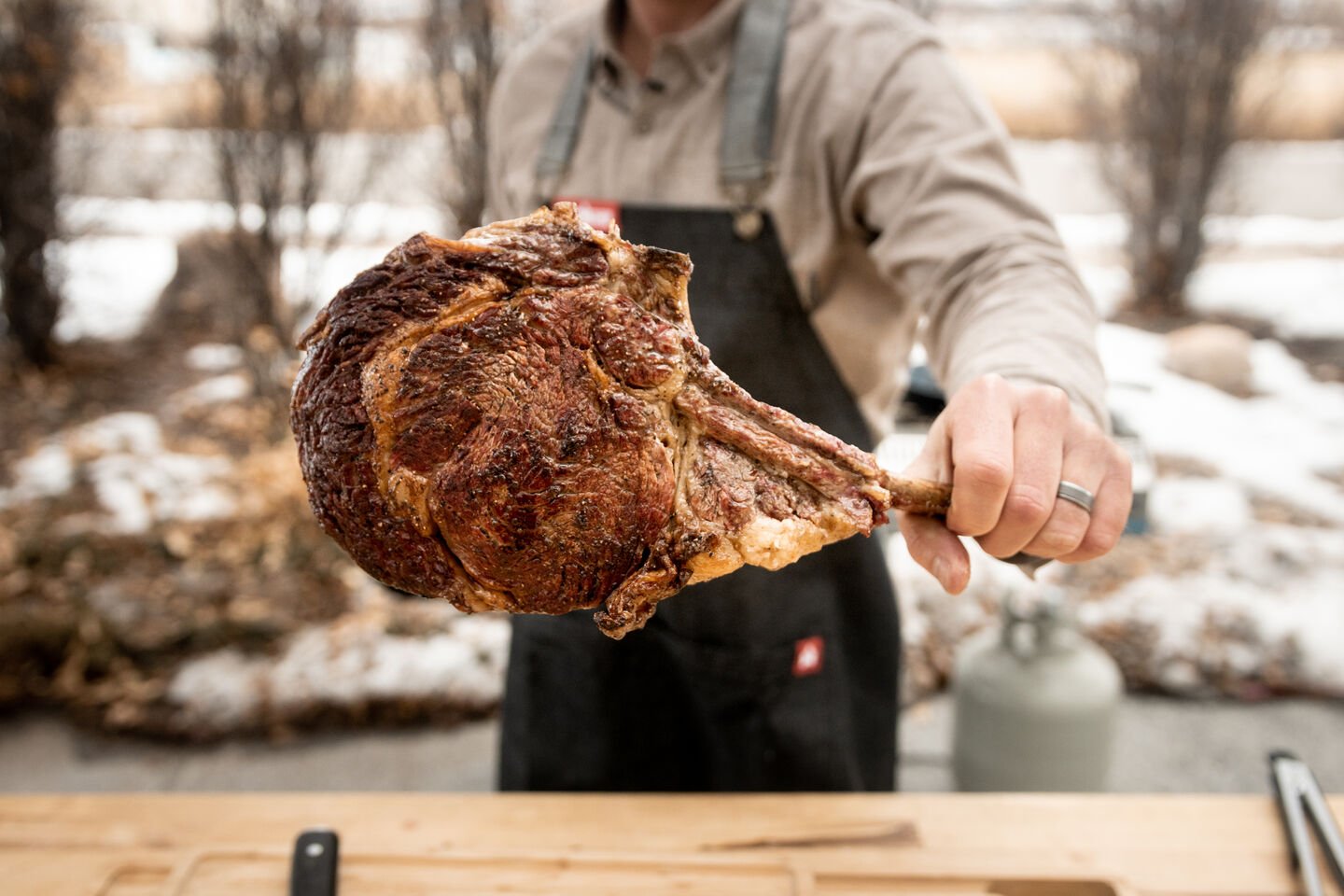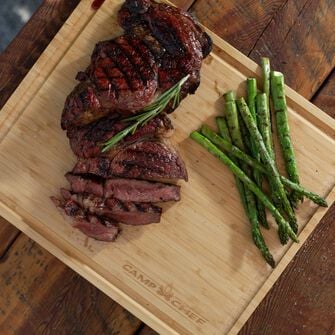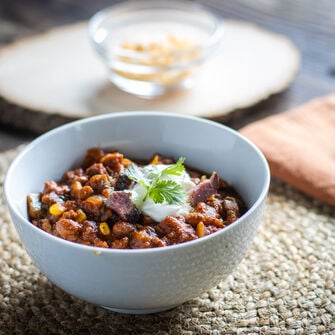
Pan Seared Steak

prep
5-10 Min

cook
6-8 Min

feeds
1
With the pan seared steak I know I can cook a better steak than most restaurants. If you want to think that steak house you go to has the best steak around this recipe isn't for you. But.... if you want to out cook those chefs give this a try!
What is the difference in a reverse sear and a traditionally pan seared seared steak?
The traditional method for cooking a steak involves searing it first over high heat, and then finishing it in the oven or on a lower heat until it reaches the desired level of doneness. This method can produce a crusty exterior and a juicy interior, but it requires careful timing and attention to prevent overcooking.
The reverse sear method involves cooking the steak low and slow in the oven or on a smoker until it reaches an internal temperature just below the desired doneness, and then finishing it with a quick sear on high heat to develop a crust. This method is preferred by some because it can produce a more evenly cooked steak with a tender texture and a flavorful crust. Cooking this steak on a pellet grill is ideal because you can go low and slow then hot and fast on the same grill.
The main difference between the two methods is the order in which the searing and cooking are done. The traditional method involves searing first, while the reverse sear method involves cooking first and then searing. Both methods have their own advantages and disadvantages, and the choice between the two ultimately comes down to personal preference. Often times when asking if traditional sear or reverse sear is better comes down to personal preference. How long to cook a steak on a pellet grill is also personal preference. How to cook a steak on a pellet grill? Again, personal preference. look like the only way to truly answer your questions is to make several steaks and see for your self.
Is a traditional or reverse seared steak better?
Whether the reverse sear or traditional sear method is better for cooking a steak is subjective and largely depends on personal preference.
The traditional sear method can produce a nicely charred exterior and a juicy interior, but it requires careful timing and attention to prevent overcooking. This method can work well for thinner cuts of steak that cook quickly, but can be more challenging for thicker cuts.
On the other hand, the reverse sear method involves cooking the steak low and slow in the oven or on a smoker until it reaches an internal temperature just below the desired doneness, and then finishing it with a quick sear on high heat to develop a crust. This method can produce a more evenly cooked steak with a tender texture and a flavorful crust, but it may not develop as much of a charred exterior as the traditional sear method.
Ultimately, the best method for cooking a steak is the one that you prefer and that works best for the specific cut of steak that you are cooking. It's worth experimenting with both methods to find the one that produces the desired result for you.
What should I look for when picking out a steak?
When selecting a good steak, there are several factors to consider:
Quality: Look for high-quality cuts of meat, ideally from grass-fed or pasture-raised animals. Look for marbling in the meat, which is the small veins of fat running through the muscle that can help to enhance the flavor and tenderness of the meat.
Cut: Different cuts of steak have different levels of tenderness and flavor. Consider the type of steak you want, such as a ribeye, filet mignon, or New York strip.
Color: The meat should be a bright, deep red color, indicating that it is fresh and of good quality. Avoid meat that is brown or gray in color.
Thickness: A thicker steak will be easier to cook to the desired level of doneness without overcooking or undercooking.
Firmness: The meat should feel firm and spring back when touched. If it feels too soft or mushy, it may not be fresh.
Age: Aged meat tends to be more tender and flavorful, as the natural enzymes in the meat have had time to break down the muscle fibers. Look for meat that has been dry-aged for at least 21 days.
Origin: Consider the source of the meat, such as a reputable butcher or a trusted farm. Knowing where the meat came from and how it was raised can give you more confidence in the quality of the product.
By considering these factors when selecting a steak, you can ensure that you are getting a high-quality piece of meat that is flavorful, tender, and easy to cook to perfection.
Does a grass fed or grain fed steak taste better?
The taste of grass-fed vs. grain-fed beef is subjective and depends on personal preference.
Grass-fed beef tends to have a more pronounced beefy flavor, with a slightly gamey or earthy taste. This is due to the fact that grass-fed cattle have a more varied diet, which can include various types of grasses, herbs, and flowers. Grass-fed beef also tends to be leaner, which can affect the texture and tenderness of the meat.
Grain-fed beef, on the other hand, tends to have a milder, sweeter flavor with a more buttery or nutty taste. This is because grain-fed cattle are typically fed a diet that is high in corn and other grains, which can affect the flavor and fat content of the meat. Grain-fed beef is also often more marbled, which can result in a more tender and juicy steak.
In general, grass-fed beef is considered to be a healthier option, as it is lower in saturated fat and higher in beneficial nutrients like omega-3 fatty acids and conjugated linoleic acid (CLA). However, the taste and texture of grass-fed beef can be different from what some people are used to with grain-fed beef.
Ultimately, the choice between grass-fed and grain-fed beef comes down to personal preference. Some people may prefer the more pronounced flavor of grass-fed beef, while others may prefer the milder, sweeter taste of grain-fed beef. It's worth trying both types of beef to see which one you prefer.
Can I grill a frozen steak?
The short answer is yes. You can grill a frozen steak. Is it the best way? No. The very key secrets to making a great steak is letting it thaw. Salt sufficiently 1 hour per inch of thickness prior to cooking. Cook until 135°F (medium rare). Let it rest for 10 minutes. Down the hatch it goes. Asking the question, can you cook a frozen steak on the grill isn't the question you should be asking. Instead ask what the best way to cook a steak is. The issue with cooking a frozen steak is the seasoning has not had time to dissolve into the fibers of the meat. If you are smoking or using a pellet grill the smoke cannot penetrate the meat until it is thawed out. Additionally, if the meat is wet the smoke cannot stick and go into it. When the steak is frozen as it thaws the moisture blocks any smoke flavor you were trying to get and could potentially develop a bitter taste.
If you forgot to take the steak out before dinner and all that is left is grilling a frozen steak go for it. We have all been there. The next question is how to grill a frozen steak. You will want to start it at low heat. Let it thaw slow enough to gently loosen the meat fibers but not so slow you are going crazy waiting for dinner. When it is closer to being thawed out crank the heat and use which ever method your heart desires.
Ingredients
1 ribeye steak, 1.5-inch thick
Coarse sea salt to taste
Black pepper to taste
1 Tablespoon olive oil
1 Tablespoon butter
Instructions
Pan Seared Steak
Step 1
Preheat your cast iron skillet on medium-high or high heat for 5-10 minutes. Preheat your oven to 500° F for 5-10 minutes as well.
Step 2
While you're waiting for the pan to heat up, season your steak with salt and pepper. Coat both sides well, using more salt than you might normally. This will give the seared crust a nice flavor.
Step 3
When the skillet is hot and you can see it begin to smoke, add olive oil to the pan. Rotate the skillet so the oil spreads across the base.
Step 4
Set your steak in the hot skillet, and press down with tongs to ensure the meat's whole surface has good contact with the cast iron. Allow to sear for 30-60 seconds.
Step 5
Flip the steak with the tongs, and allow it to sear for another 30-60 seconds. Then remove from burner and set the entire skillet in the oven. Allow to cook for 2 minutes on one side, then flip and cook for another 2 minutes on the other side in the oven. You can adjust the cooking time to get the level of doneness that you prefer. Use a thermometer to get an exact reading; for medium rare, pull your steak at 125° F.
Step 6
Alternatively, you can skip using your oven and just leave the steak cooking on the stove for 4-5 minutes. If you use this method, you should flip the steak often, about every 15-30 seconds. Despite what many people think, flipping a steak multiple times does not negatively impact the final product. In fact, it can help speed up cook time and give you more even heat on both sides of the meat.
Step 7
Whether you use your oven or the stovetop, add some butter to the skillet in the last minute or two of cooking. Spoon it over the steak repeatedly to baste.
step 8
Remove steak from the skillet. Allow it to rest for 5-10 minutes with a foil tent. Then cut it against the grain, and enjoy!





